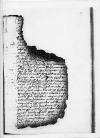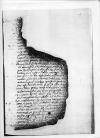Post novissimas ⌊Viennae⌋ in ⌊Austria⌋ ad me Dominationis
Vestrae Reverendissimae datas ⌊⌋, quibus tum abunde
⌊⌋, et hinc cum ⌊caesar⌋ ageret ⌊Bononiae⌋, Dominationi Vestrae Reverendissimae de iis, quae eo tempore se offerebant, scripsi, nullas vidi hactenus, quod magnis occupationibus in amplissima illa dignitate, quam paulo post Dominatio Vestra Reverendissima pro innumeris suis virtutibus et in ⌊serenissimum regem suum⌋ innumeris meritis assecuta est, vel etiam tam vastae locorum intercapedini, quae nos
disiungit, vel tabellariorum incuriae imputo. Ceterum neque
dici neque scribi potest, quanto sim affectus gaudio, cum
certo esset ad me perlatum Dominationem Vestram
Reverendissimam archiepiscopali sublimitate decoratam in summa apud ⌊regem suum⌋ honorari gratia et
haberi existimatione. Gestiensque tunc ⌊Dantiscus⌋ suum illum olim commilitonem Cranmerum, quo cum
amicissime coniunctissimeque in aula ⌊caesaris⌋ vixit et a quo humanissime in discessu ex ⌊Ratisbona⌋
usque ad
⌊Danubium⌋, immo usque in ipsum navigium honoris causa deductus fuit, in ea dignitatis celsitudine et videre et venerari summopere
cupivit. Solet enim hoc bonis accidere amicis, cum amicus quispiam fortunae pinguioris nactus est condicionem, quod et se illa beatos esse arbitrentur. Non potui itaque committere, quin has rudes gratulatorias sed ex vera propensione
profectas ad Dominationem Vestram Reverendissimam darem. Quae licet serius veniant, non tamen sera congratulatio debet ab amico
reprehendi. Quod quidem et mihi mutuae nostrae amicitiae iure peto concedi etc.
Quae et quantae rerum mutationes interea,
quo aDominatione Vestra Reverendissima abii,
successerunt, nemini sunt incognitae, totus orbis iis
periculosis temporibus plenus turbis est
et tumultibus tamquam varia de iis, quae
geruntur incertis plerumque rumusculis passim
circumferuntur, ut difficulter ex illis, quae veriora
sunt, elici possint. Ex vestra ⌊Britannia⌋ ea, quae ad nos
perlata sparguntur, de religione, maxime a... ⌊regis vestri⌋, omnem paene excedunt fidem, neque earum rerum quippiam credere in anim um induxi priusquam de singulis a Dominatione Vestra Reverendissima fiam certior. Non praeterit Dominationem Vestram Reverendissimam, quantus semper laudum et virtutum ⌊serenissimi regis vestri⌋ ab eo tempore, quo eius maiestatem vidi orator, praeco fuerim, nec destiti apud ⌊serenissimos reges nostros⌋, praecipue apud ⌊serenissimam reginam dominam meam⌋ clemenentissimam commemorare, quantis animiet corporis
dotibus quantaque prudentia et eruditione
serenissimus rex vester polleat, unde persuaderi non potest vera esse, quae a ⌊Belgi[s]⌋ et a curia ⌊caesaris⌋ ad nostros scribuntur in eo potissimum,
quae de matrimonio novissimo, ut reor, ab osoribus conficta habentur. Qua de re a
Dominatione Vestra Reverendissima impense oro, quomodo haec omnia transacta sunt, pro illa nostra humanissima inter nos contracta consuetudine per hunc, qui has reddet, me
litteris suis edocere velit. Quod si adhuc ⌊serenissimus
rex vester⌋ a firmo coniugio immunis esset, et ego eius maiestati pro mea summa in eam observantia, hic apud ⌊serenissimos reges⌋ meos et ⌊reginam⌋
inservire possem, nil est, quod libentius atque accuratius facerem.
Proinde Dominationem Vestram Reverendissimam latere nolui esse apud nos ⌊filiam⌋ virginem vere regiam, ex serenissimo ⌊rege⌋ et hodierna ⌊regina⌋
clarissimis natalibus prognatam, quae aetatis decimum octavum ingreditur annum. ⌊Puella⌋ est formosissima et succi, ut est in proverbio, plena. Nomen illi
est ⌊Isabella⌋, omnibus virutibus ornata atque inde ⌊serenissimis
parentibus⌋ ac regnicolis omnibus longe carissima neque dos regia tanta virgine digna
deest, et quod dote praeclarius optabiliusque
esse debet, futurae spes fecunditatis, quam forma corporis non obscuris prae se fert signis. Si, inquam, ⌊serenissimus rex vester⌋ adhuc certo
matrimonio implicatus non esset, se digniorem reginam, unde ⌊regni vestri⌋ heredes, qui omnium votis expetuntur, nascerentur clarissimi habere non posset. Eam ad rem, si sic sors tulerit, omnem meam diligentiam et
operam offero, modo Dominatio Vestra Reverendissima, si quid forsan in eo Deus statuere voluerit, de voluntate ⌊serenissimi regis vestri⌋, cui me
humiliter commendari rogo, certum me faciat. Neque hoc omittendum censui illustrissimam istam ⌊puellam⌋ dono linguarum esse locupletem. Praeter
nativum sermonem Polonum Italice et Latine expedite loquitur usa matre, docta et prudentissima ⌊regina⌋, et non alio praeceptore. Accedit et lingua Germanica, quam iis temporibus ab eius linguae puellis non parva ex parte didicit. Multa praeterea transeo, quae ad generosissimae huius puellae laudem essent addenda. Res ipsa si forsan sic acciderit, longe plura proferet. Atque utinam tam laudatus rex talem aliquando habeat reginam, non male regni vestri reipublicae esset consultum.
Haec confidenter et pro mutuae nostrae amicitiae fiducia non vulgari in sinum Dominationis Vestrae Reverendissimae effundere statui fore sperans, quod vicissim litteris suis mentem in iis suam mihi declarabit, cum non alio ista ex me pro cedant, quam ex summa mea erga ⌊serenissimum regem vestrum⌋ observantia, et quod eius maiestati pro ea benignitate, qua me in aula sua prosequebatur, volo optime in omnibus etc.
De absentibus amicis maior quam de iis, qui coram sunt, cura haberi solet. Quo fit, quamvis sciam Dominationem Vestram Reverendissimam in eo constitutam statu, ut nihil illi felicitatis addi possit, quod nihilosecius, tamen summopere ab ipsamet Dominatione Vestra Reverendissima cognoscere aveo, quomodo in omnibus habeat neque tam benigna esse potest
in Dominationem Vestram Reverendissimam fortuna, quin velim illam esse longe benigniorem.Gratum igitur mihi faciet plurimum, si mihi de statu rerum suarum notitiam fecerit.
De me si forte parem
Dominatio Vestra Reverendissima gerit solicitudinem,
haec accipiat. Rediens huc postliminio ad patriam (quemadmodum prius scripsi Dominationi Vestrae Reverendissimae) ⌊principibus meis⌋ et omnibus gratus eram. Verum magni brevis est fortuna favoris, quem evestigio sequi solet invidia, qua aliquamdiu male fui affectus. Atqui Deo tandem et veritate duce superavi omnes inimicos meos, quantumvis iniquissime oppugnabar ab illis, vicit omnium fortior veritas, summa prudentia et aequitate serenissimorum principum meorum suffulta utque illam clariorem ac notiorem omnibus efficere possim, quo hostes mei pudefiant et cum technis eorum cognoscantur, statui me hinc in causis reipublicae nostrae si me per gratiam
principum meorum explicare non potuero cum aliis harum terrarum consiliariis ad comitia regni nostri propediem futura conferre, multis ad id nostratium precibus inductus, quibus reluctari diutius
neque potui neque debui non omissurus in omnem eventum, si adhuc serenissimus
rex vester a matrimonio liber est, explorare in hiis serenissimorum principum
meorum animos, quos iampridem serenissimo regi vestro plurimum propensos et faventes esse cognovi.
Quod si haec mea molimina fortassis
frustra concepta non proderunt, certe non nocebunt, mutuae
benevolentiae et fraterno amori, qui inter
vestrum et meos est principes, quandoquidem ex eiusmodi tractatibus contracta amicitia fieri solet firmior atque auctior. Quicquid itaque Dominatio Vestra Reverendissima in iis, si adhuc restat occasio, per me geri velit, mihi cum primis significet in eo et in quibusvis aliis, quae praestare possum vel ad digituli crepitum Dominationi Vestrae Reverendissimae sum non gravate obsecuturus. Quod de iis adeo large ad Dominationem Vestram Reverendissimam hac manu mea, quae satis male pingit, nihil rhetoricatus putans me coram cum Dominatione Vestra
Reverendissima, ut consuevi, pure et simpliciter colloqui scripserim, in causa non fuit aliud, quam amor meus et observantia in Dominationem Vestram Reverendissimam perpetuo duratura, et nisi eam vererer temporaria et prolixiori scriptione mea, quae calamum ultro currentem impellit, offendi, ex epistola volumen cresceret, non solum de iis, de quibus amor et
consuetudo nostra Ratisbonensis scribendi argumenta offert, verum etiam de temporibus et
amicis nostris, quos tamen non omnes praeterire potui, imprimis autem reverendum dominum ⌊doctorem Samsonem⌋, cum quo tot annis mihi fuit in ⌊Hispaniis⌋ et novissime in coronatione ⌊caesaris⌋ ⌊Bononiae⌋ summa familiaritas, nobilissimum item dominum ⌊Thomam Eliotam⌋ equitem auratum. Quos dominos, ne reliquis Dominationem Vestram Reverendissimam onerem, ex animo et, quoad vires meae possunt, salvere iubeo omniaque eis faustissima precor a Dominatione Vestra Reverendissima summopere orans atque pro mutuae nostrae amicitiae iure postulans, ut hanc meam in eos inexstinctam benevolentiam in notitiam illorum deducere non velit gravari. Si quid hic pro illis, maxime autem pro Dominatione Vestra Reverendissima possum, ipse subibo humeris nec me labor iste gravabit. Dominus Deus eandem Dominationem Vestram Reverendissimam quam diutissime sospitet et prosperet in omnibus.







